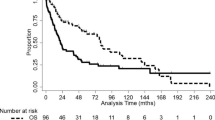Abstract
Background
The clinical outcome of glioblastoma (GBM) patients who receive radiotherapy alone or with chemotherapy is well established. However, little is known about how many patients do not receive this treatment. We consider it is important to investigate why a proportion of operated patients do not receive further treatment after surgery.
Methods
We reviewed all consecutive GBM patients operated on in our hospital between January 2000 and December 2008.
Results
A total of 216 patients with GBM were identified. Fifty-five (25%) did not receive any treatment after surgery. Univariate analysis showed that factors associated with no further treatment after surgery were older than 60 years (p=0.002), of female gender (p=0.03), had a KPS<70 (p<0.001) and had had a biopsy (p<0.001). Multivariate analysis indicated that age ≥60 years and KPS <70 were independent predictors of no further treatment after surgery. Gender was not an independent variable. However, women in the whole series were older than 60 years (p=0.01), and they had a worse KPS (p=0.02) and more biopsies (p=0.04) than men. In the whole group, median survival time was 10.4 months for men (n=125) vs. 7.2 months for women (n=91), log rank p<0.04. This difference was not observed in the group that was treated after surgery.
Conclusions
One out of four patients could not be treated after surgery. Independent predictors were older age and low KPS. These poor risk variables were more frequent in women and their survival was therefore lower than men in our series.
Similar content being viewed by others
References
Stupp R, Mason WP, van den Bent MJ et al (2005) Radiotherapy plus concomitant and adjuvant temozolomide for glioblastoma. N Engl J Med 352: 987–996
Stupp R, Hegi ME, Mason WP et al (2009) Effects of radiotherapy with concomitant and adjuvant temozolomide versus radiotherapy alone on survival in glioblastoma in a randomised phase III study: 5-year analysis of the EORTC-NCIC trial. Lancet Oncol 10:459–466
Ohgaki H, Dessen P, Jourde B et al (2004) Genetic pathways to glioblastoma: a population-based study. Cancer Res 64:6892–6899
Paszat L, Laperriere N, Groome P et al (2001) A population-based study of glioblastoma multiforme. Int J Radiat Oncol Biol Phys 51:100–107
Winger MJ, Macdonald DR, Cairncross JG (1989) Supratentorial anaplastic gliomas in adults. The prognostic importance of extent of resection and prior low-grade glioma. J Neurosurg 71:487–493
Kleihues P, Cavenee WK, Scheithauer BW et al (2002) World Health Organization classification of tumours: pathology and genetics of tumours of the nervous system. J Neuropathol Exp Neurol 61: 215–225
Macdonald DR, Cascino TL, Schold SC Jr, Cairncross JG (1990) Response criteria for phase II studies of supratentorial malignant glioma. J Clin Oncol 8:1277–1280
Chang SM, Barker FG 2nd (2005) Marital status, treatment, and survival in patients with glioblastoma multiforme: a population based study. Cancer 104:1975–1984
Weller M, Felsberg J, Hartmann C et al (2009) Molecular predictors of progression-free and overall survival in patients with newly diagnosed glioblastoma: a prospective translational study of the German Glioma Network. J Clin Oncol 27: 5743–5750
Filippini G, Falcone C, Boiardi A et al (2008) Prognostic factors for survival in 676 consecutive patients with newly diagnosed primary glioblastoma. Neuro Oncol 10:79–87
Chang SM, Parney IF, Huang W et al (2005) Glioma Outcomes Project Investigators. Patterns of care for adults with newly diagnosed malignant glioma. JAMA 293:557–564
Caloglu M, Yurut-Caloglu V, Karagol H et al (2009) Prognostic factors other than the performance status and age for glioblastoma multiforme. A singleinstitutional experience. J BUON 14:211–218
Reavey-Cantwell JF, Haroun RI, Zahurak M et al (2001) The prognostic value of tumor markers in patients with glioblastoma multiforme: analysis of 32 patients and review of the literature. J Neurooncol 55:195–204
Brockmann MA, Giese A, Mueller K et al (2007) Preoperative thrombocytosis predicts poor survival in patients with glioblastoma. Neuro Oncol 9:335–342
Author information
Authors and Affiliations
Corresponding author
Rights and permissions
About this article
Cite this article
Verger, E., Valduvieco, I., Caral, L. et al. Does gender matter in glioblastoma?. Clin Transl Oncol 13, 737–741 (2011). https://doi.org/10.1007/s12094-011-0725-7
Received:
Accepted:
Published:
Issue Date:
DOI: https://doi.org/10.1007/s12094-011-0725-7




